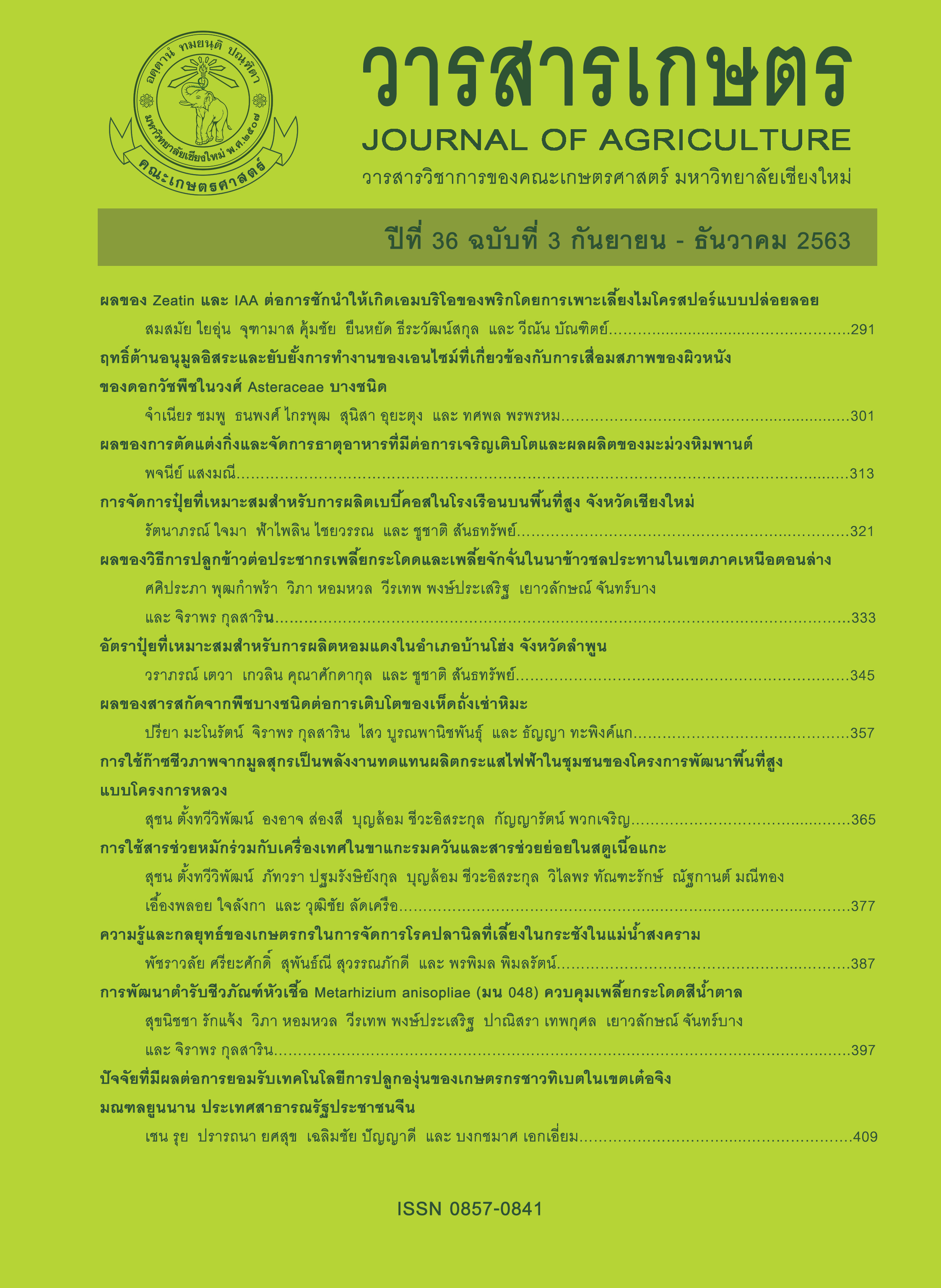ผลของการการตัดแต่งกิ่งและจัดการธาตุอาหารที่มีต่อการเจริญเติบโต และการให้ผลผลิตของมะม่วงหิมพานต์
Main Article Content
บทคัดย่อ
มะม่วงหิมพานต์ (Anacardium occidentale) เป็นพืชเศรษฐกิจของจังหวัดอุตรดิตถ์และมีพื้นที่เพาะปลูกมากที่สุดในประเทศไทย ส่วนใหญ่เป็นการเพาะปลูกแบบอาศัยน้ำฝน สภาพดินมีความเป็นกรดจัดรุนแรง ไม่มีการจัดการใดๆ และรอเก็บเกี่ยวผลผลิต ปัจจุบันประสบปัญหาช่อดอกแห้งและผลผลิตตกต่ำ การวิจัยนี้มีวัตถุประสงค์เพื่อหาเทคโนโลยีในการเพิ่มผลผลิตมะม่วงหิมพานต์ที่เหมาะสมกับพื้นที่ สำหรับส่งเสริมการเพาะปลูกให้แก่เกษตรกร โดยทำการศึกษาในแปลงของเกษตร ใช้ต้นมะม่วงหิมพานต์อายุ 15 ปี ขนาดทรงพุ่ม 4-6 เมตร จัดกรรมวิธีการทดลองแบบ 2x2 Factorial วางแผนการทดลองแบบสุ่มในบล็อคสมบูรณ์ (RCBD) จำนวน 10 ซ้ำๆ ละ 1 ต้น มีปัจจัยที่ศึกษา ได้แก่ การตัดแต่งกิ่งและการจัดการธาตุอาหารพืช ใช้การตัดแต่งกิ่งแบบครึ่งวงกลม เพื่อให้แสงส่องผ่านประมาณ 60% ของทรงพุ่ม และ การจัดการธาตุอาหารทางดินโดยพิจารณาจากค่าวิเคราะห์ดินร่วมกับพ่นปุ๋ยทางใบที่มีธาตุอาหารรองและจุลธาตุอาหารร่วมกับน้ำตาลกลูโคส จากการศึกษา พบว่า ปัจจัยการจัดการธาตุอาหารส่งผลต่อการเจริญเติบโตในทุกระยะ ตั้งแต่การแตกใบอ่อน ขนาดช่อดอก การติดผล น้ำหนักเมล็ด ไปจนถึงปริมาณผลผลิต ในขณะที่การตัดแต่งกิ่งเริ่มส่งผลต่อพืชในระยะเริ่มให้ผลผลิตไปจนถึงเก็บเกี่ยวผลผลิต การตัดแต่งกิ่งร่วมกับการให้ธาตุอาหารทำให้เกิดการแตกใบอ่อน 100% และมีการพัฒนาช่อดอกพร้อมกันขนาด 25-28 เซนติเมตรภายใน 3 สัปดาห์หลังจากได้รับธาตุอาหารทางใบ ส่วนการตัดแต่งกิ่งหรือได้รับการจัดการธาตุอาหารเพียงอย่างใดอย่างหนึ่งมีการแตกใบอ่อน 75-78% และมีขนาดช่อดอก 16-17 เซนติเมตร พบปฏิกิริยาสัมพันธ์ระหว่างปัจจัยการตัดแต่งกิ่งและการจัดการธาตุอาหารที่มีต่อจำนวนเมล็ด/ช่อดอก น้ำหนักเมล็ด และปริมาณผลผลิต โดยการตัดแต่งกิ่งร่วมกันการจัดการธาตุอาหาร ทำให้มะม่วงหิมพานต์มีระยะพัฒนาผลไปจนถึงการเก็บเกี่ยวยาวนานขึ้นเป็น 4 เดือนและมีอาหารเพียงพอสำหรับการติดผลและบำรุงเมล็ดมะม่วงหิมพานต์ และทำให้มะม่วงหิมพานต์มีการติดเมล็ด 12.80 เมล็ด/ช่อ น้ำหนักเมล็ด 6.50 กรัม และผลผลิตเฉลี่ย 10.93 กิโลกรัม/ต้น ในขณะที่กรรมวิธีอื่น ทำให้ได้ผลผลิตน้อยกว่าอย่างมีนัยสำคัญทางสถิติ (P<0.01) มีการติดเมล็ด 1.19-3.29 เมล็ด/ช่อ น้ำหนักเมล็ด 3.83-4.87 กรัม และผลผลิตเฉลี่ย 2.32-3.94 กิโลกรัม/ต้น ดังนั้น วิธีการที่เหมาะสมสำหรับการส่งเสริมเกษตรกรคือการตัดแต่งกิ่งร่วมกับการปรับปรุงดินและใส่ปุ๋ยตามค่าการวิเคราะห์ดินในช่วงต้นฤดูฝน และพ่นปุ๋ยทางใบที่มีธาตุอาหารรองและจุลธาตุอาหารร่วมกับน้ำตาลกลูโคสทุกสัปดาห์ทุกสัปดาห์ก่อนการแตกใบอ่อนไปจนถึงระยะบำรุงเมล็ด
Article Details
เอกสารอ้างอิง
Anupunt, P. and U. Nopkoonwong. 1992. Yield trial of commercial varieties and selected clones of cashew. Acta Horticulturae 321, doi: 10.17660/ActaHortic.1992.321.22.
Beena, B., M.A. Salam and P.A. Wahid. 1995. Root activity of cashew (Anacardium occidentale L.) varieties in relation to phonological phases. Journal of Plantation Crops 23(1): 35-39.
Bustan, A., E.E. Goldschmidt and Y. Erner. 1996. Carbohydrate supply and demand during fruit development in relation to productivity of grapefruit and ‘Murcott’ mandarin. Acta Horticulturae 416, doi: 10.17660/ActaHortic. 1996.416.9.
Chaikiattiyos, S. 2019. Integrated production practices of cashew in Thailand. (Online). Available: http://www.fao.org/3/ac451e/ ac451e09.htm. (October 17, 2019).
Hiranpradit H., S. Chandraparnik and S. Salakpetch. 2003. Production Technology of Durian. Kasetsart University Press, Bangkok. 206 p. (in Thai)
Jirapaet, J. 2013. Phenological development and changes of carbohydrate, nitrogen and phosphorus in leaves of mangosteen and longkong at Narathiwat province. Princes of Naradhiwas University Journal 5(1): 69-78. (in Thai)
Jøker D. 2003. Information about cashew nut (Anacardium occidentale). (Online). Available: http://www.hubrural.org/IMG/pdf/ anacarde_danida.pdf. (March 19, 2020).
Maneepong, S. 2013. Nutrient management for quality pumelo production. School of Agricultural Technology. Walailak University, Nakhon Si Thammarat. 131 p. (in Thai)
Nayak, M.G. 2011. Pruning and canopy architecturing in cashew. Codeword and process and printers, Mangalore. 24 p.
Sakdiset, N. and S. Sanputawong. 2016. The canopy height control and arrangement main branch for quantity and quality of mangosteen (Garcinia mangostana Linn.). Songklanakarin Journal of Plant Science. 3 (Suppl. 1): MO4/76-80. (in Thai)
Sangmanee, P., C. Mingchai and S. Palas. 2018. Management system for commercial organic langsat production. Final report. The Thailand Research Fund, Bangkok. 38 p. (in Thai)
Sangmanee, P. 2019. Development of software application delivery through smart phones: A plant nutrition management tool for geographical indication and identity plants of Uttaradit. Final report. Uttaradit Rajabhat University Research Fund, Uttaradit. 60 p. (in Thai)
Santasup, C. 2009. Nutrient management. pp. 227-246. In: T. Radanachaless, W. Kumpoun and T. Jaroenkit (eds). Mango: Production and Post-harvest Technology. Post-harvest Technology Innovation Center, Office of Higher Education Commission, Chiang Mai. (in Thai)
Senanan, C., P. Manochai, W. Suton, S. Ussahatanonta and J. Srijun. 2011. Effect of 4 pruning patterns on leaf flushing, flowering, yield, cost and profit of longan trees cv. Daw. Journal of Agricultural Research and Extension 28(1): 1-9. (in Thai)
Tanongjid, K., P. Karintanyakit, K. Suvittawat, R. Komkhuntod and P. Phengchang. 2016. Effect training on leaf flushing of avocado cv. Peterson. Songklanakarin Journal of Plant Science 3 (Suppl.1): MO4/22-26. (in Thai)
Uttaradit Provincial Agriculture and Cooperatives Office. 2019. Agricultural data of Uttaradit province. (Online). Available: https://www.opsmoac.go.th/uttaradit-dwl-files-421091791011. (March 19, 2020). (in Thai)
Wanichkul, K. 2003. Training and pruning fruit trees. Kasetsart University Press, Bangkok. 213 p. (in Thai)
Wanichkul, K. and P. Kanchanakesorn. 2008. Flowering and fruit set of Java apple (Syzygium samarangense (Blume) Merr. & Perry) cv. ‘Thabthimchan’ as affected by 4 training systems in high density planting. KMUTT Research and Development Journal 31(3): 539-547. (in Thai)
Wünsche, J.N. and Lakso, A.N. 2000. Apple tree physiology-implications for orchard and tree management. pp. 82-88. In: Proceeding of 43rd annual IDFTA conference, Napier.


